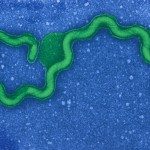Link to Pubmed [PMID] – 40631289
Link to DOI – 10.1101/2025.07.04.663154
bioRxiv 2025 Jul; ():
Understanding the genetic basis of ecological adaptation is a fundamental challenge of evolutionary biology, often limited by the availability of diverse and curated datasets. Spirochaetes are widely distributed, ancient bacteria found in diverse environments, offering a unique opportunity to explore ecological transitions. Despite their high diversity and the presence of globally important pathogens such as syphilis (Treponema spp.), Lyme disease (Borrelia spp.), or leptospirosis (Leptospira spp.), Spirochaetes remain poorly characterized as a phylum. Moreover, the recent discovery of non-spiral lineages has broadened its complexity and require a re-evaluation of the entire phylum’s evolution. Here, we present the most comprehensive phylogenomic and functional analysis of Spirochaetes, examining a curated dataset of 172 spirochaetal genomes representing all cultivable spirochete species. Our robust phylogenetic framework revisits the evolutionary rooting of this phylum and reveals that the Last Spirochaetal Common Ancestor (LSCA) diverged into two major clades, with Brachyspira species diverging early from the rest of Spirochaetes. Ancestral genome reconstruction showed that the LSCA was a motile, endoflagellated bacterium with a heterotrophic metabolism, shedding light on the biology of one of the most anciently diverging bacterial phyla. Functional analysis revealed genomic signatures associated with key phenotypic adaptations within Spirochaetes, such as independent loss of the characteristic spiral morphology and emergence of host-associated lineages. Notably, we found that loss of endoflagellar genes correlated with the appearance of non-spiral species. Lastly, we employed phylogenetic profiling to identify previously uncharacterized motility-associated gene families, whose role was then demonstrated experimentally. Overall, this study provides new evolutionary insights into how ecological specialization has shaped spirochete genomes, offering a framework to elucidate further the mechanisms driving key evolutionary transitions in this clinically relevant phylum.

